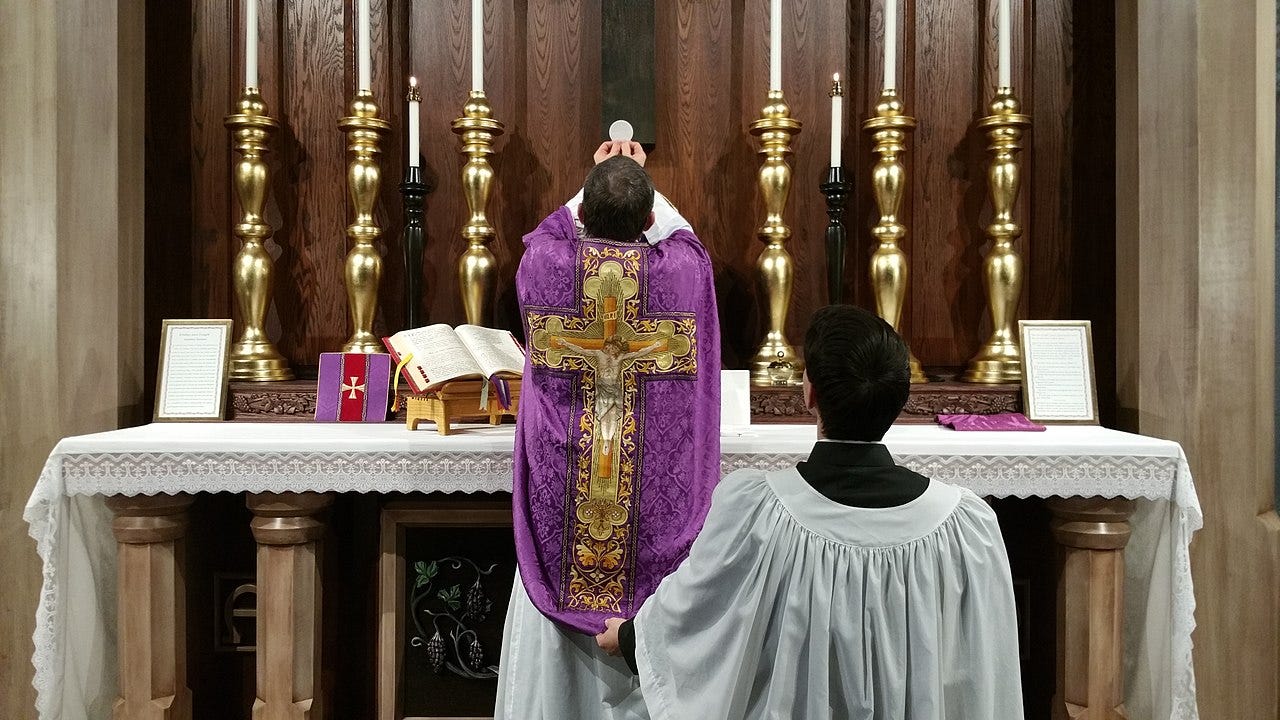How does the Advent Liturgy point towards the Second Coming?
Advent does not just prepare us for Christmas, but also for the second coming of Christ.

Advent does not just prepare us for Christmas, but also for the second coming of Christ.
Advent is a period of hope and preparation, beginning four Sundays before Christmas.
Remembering that Christ’s advent in the flesh, to save us from our sins, is a source of hope and joy. But remembering what has already happened does not exhaust the hope which the season of Advent has to offer us—especially in our period of ecclesiastical chaos and the emergence of a global system of tyranny.
In fact, there is another aspect to the hope of Advent, which can provide us with sure reasons for hope, even today.
This is a part of our series The Roman Liturgy – an ongoing series of standalone pieces about the liturgy, hope, and the crisis in the Church.
For what, exactly, are we preparing in Advent?
There are several ways of answering this question.
One way is to refer to devotional traditions and practice; another is to look at the texts of the Liturgy. There is a great deal of crossover between the two; but there are some significantly different emphases.
Based on our devotional practices, hymns, prayers and stories, Advent seems to be focused around the mysteries that lead up to the Nativity (such as the Annunciation, the expectation over nine months, the journey to Bethlehem, and so on).
We know from Catholic tradition that there is a real fruit to be had in meditating on the state of the world before Christ’s coming, and to imagine ourselves in that time. The purpose of this is to stir up an atmosphere or preparation and expectation for Christ’s coming. The Roman Church appears to put its seal on this expectation for Christ's coming, not least through the texts used throughout her traditional liturgy.
But which coming? Christ has already come in the flesh. Does the Church, therefore, want us only to engage in a kind of “make-believe,” in which we pretend that we are living in the time before Christ’s birth, and try, by these means, to create an atmosphere of preparation and expectation for something that was realised long ago?
There is nothing wrong with this, and it can be a spur for prayer and meditation. There are many beautiful treatments of this by spiritual writers, and remembrance of the state of the world before Christ will always remain a feature of Advent.
But if this remembrance is too exclusively the focus, then we may be liable to flatten the season, and miss out on the riches which its liturgy offers.
This is why spiritual writers (such as Dom Columba Marmion’s Christ in His Mysteries) treat Advent as a preparation for Christ being born into the soul of each individual Christian—the very purpose of our life on earth.
This is an especially important time for teaching our children about our holy religion, and for creating memories which they will cherish forever. There are many beautiful and holy practices for Advent that unite the idea of Christ’s birth in our hearts with that of his coming in the flesh. For example, we might set a manger in our crib, with children striving to make it comfortable for the Christ-child by adding a piece of straw for each good deed.
However, spiritual writers also discuss a third “birth”—namely, his eternal generation by the Father. Dom Prosper Guéranger links these three births to the three Masses of Christmas:
“… Jesus, who is born tonight, is born thrice. He is born of the Blessed Virgin, in the stable of Bethlehem [Midnight Mass]; He is born by grace, in the hearts of the Shepherds, who are the first fruits of the Christian Church [Dawn Mass]; and He is born eternally from the bosom of the Father, in the brightness of the Saints [Day Mass]: to this triple birth, therefore, let there be the homage of a triple sacrifice.”1
However, in these same classic books on the Church’s liturgy and liturgical year, we also find another advent of Christ presented as the object of our hope and preparation. This is the “Parousia,” or Christ’s coming in majesty at the end of the world, to judge the living and the dead.
Dom Prosper Guéranger writes in his description of “the mystery of Advent”:
“[The Church aspires after a third coming, which will complete all things by opening the gates of eternity. […] She is impatient to be loosed from her present temporal state; she longs for the number of the elect to be filled up, and to see appear, in the clouds of heaven, the sign of her Deliverer and her Spouse.”2
But aside from the Gospel of the First Sunday of Advent, the Parousia barely figures in our observation of Advent at all. It barely figures in the stories we tell our children, the prayers we pray at home, or carols we sing (though it is there—consider Joy to the World and Once in Royal David’s City).
The question we must ask is: Are we missing out on something that the Church wants for us?
This is a members-only post for those who support us with monthly or annual subscriptions. It’s a part of our series The Roman Liturgy on the liturgy, and reasons for hope amidst the crisis in the Church.
Our work takes a lot of time and energy. Please consider subscribing if you like it.
Here’s why you should take out a membership of The WM Review today:
Help us continue building the case for a restrained, theological approach to the crisis in the Church
Support an eclectic and sometimes eccentric variety of content
Provide FREE membership to clergy/seminarians (subscribe and reply to the email if this applies to you.)
A small monthly membership really helps us keep The WM Review going. Can you chip in today?

